Indian Automotive Industry
The automotive industry in India became the fourth largest industry in the world in 2019, surpassing Germany in terms of sales. India now plans to surpass Japan to become the third largest auto market by 2023[1], only leaving China and US to be ahead of it in terms of sales. The Government of India aims to develop India as a hub for global manufacturing as well as research and development. India has set up National Automotive Testing and R&D Infrastructure Project Centers to promote research and development in the industry [2]. The Indian Automotive Industry at present contributes to around 7% to the GDP and the Government aims to enhance this contribution to 10% by 2026.
Passenger Vehicle (PV) is a motor vehicle which has at least four wheels and not more than 8 seats are allowed in addition to the driver’s seat. The contribution of PV Industry is almost 13% to the Indian Automotive Industry. The PV Industry is roughly a 33 Lakh annual sale unit market. There was a drop-in sale of PVs due to the change in emission norms in 2019 when the Government of India instituted to regulate the emission norms to stop the sale of BSIV vehicles and only allowing BSVI vehicles to be sold after March, 2020. The year 2022 has shown healthy signs of recovery wherein the passenger car segment has grown by more than 10% over the last year. Even driven under the influence of green initiatives and a continuous hike in fuel prices, Fig 1 clearly indicates a significant increment in car ownership across the various states of India (2018 vs 2019-2021).
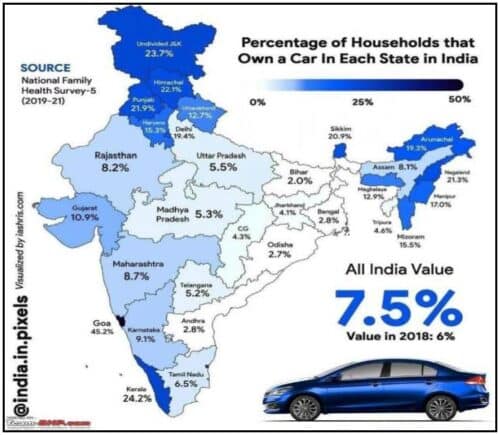
Source: – National Family Health Survey
This article highlights the role of Electronics and its applications in meeting the safety requirements in the automobiles sector especially in the luxury segment of passenger vehicles.
Passenger Vehicle Segment in India
The sale of passenger vehicles contributes to around 13% in the total sales of Automotive Industry of India. In this segment, the luxury cars contribute to 1%. Fig 2 depicts the variation in the sales of the Passenger Vehicle segment over the last decade along with the sales of the Luxury vehicles.
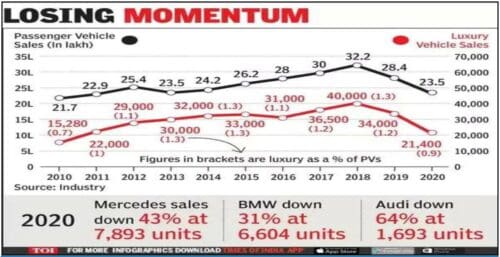
Source: – https://timesofindia.indiatimes.com/business/india-business/luxury-cars-skid-clock-lowest-sales-since-2010/articleshow/80263733.cms
Most of the car manufacturers have now begun to pitch and advertise their products based on safety of the vehicle. Amongst the small and mid-segment cars, Mahindra XUV 300, Tata Nexon, Tata Tiago, Mahindra Marazzo, Volkswagen Polo are some of the cars that have been promoted as the safest cars in India. The luxury car manufacturers like the Mercedes-Benz, Audi, BMW, Volvo, Land Rover and others are also following in the same steps. Safety tops the feature list of customers even in the luxury segment. And most of the features related to safety are derived with the aid of Electronics and its applications. Fig 3 exhibits the features available in automobiles, most of which are controlled by Electronics hardware and soft computing techniques.
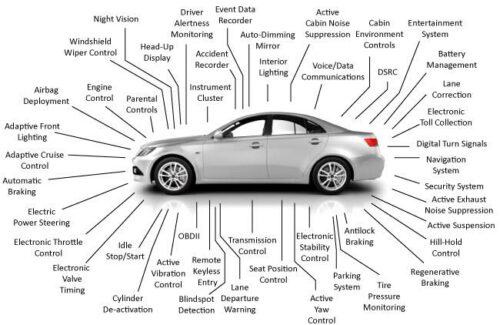
Source: – https://www.elprocus.com/power-electronics-in-automotive-applications/
As per Newton’s first law of motion, a body inside a moving car tends to be in motion. Unless it is harnessed using a nylon/high tensile polyester filament yarn having standard dimension (60, 74 or 90 inch length X 46-49 mm width) connecting the vital, sturdy parts of the human skeletal system – the shoulder, the rib cage and the pelvic bones by an integrated three point assembly that can withstand sudden jolts to the tune of 1000 lbs of force; popularly known as the SEATBELT. Invented by George Cayley in the late 1800s, it is Swedish engineer Nils Bohlin in 1958 who designed the three-point seatbelt for Volvo through an open patent – freely shared with others under a copyleft – like license. Ford demonstrated its inflatable safety belt in 2001 where a shoulder belt containing an airbag would instantaneously inflate when a car is in a collision – again an open patent. Electronic circuitries, associated with this humble seatbelt, in the recent past have made it possible to generate audible alarms / alert sounds; lasting for variable durations as a buckle up indicator. While seatbelt has now become a basic feature of safety in all the passenger vehicles manufacturers, there are many other safety features available in the luxury segment of PV, guided by control, automation and soft computing techniques, but primarily electronically controlled. A handful of such features are explored here.
Safety features in Passenger Cars driven and controlled by Electronic appliances
1. Anti-Lock braking System
An Anti-lock Braking System is a safety braking system used in cars to prevent its wheels from locking during braking. It allows to maintain tractive contact with the road surface. This system helps the driver to maintain more control on the car. It includes a central Electronic Control Unit (ECU), speed sensors for each wheel, at least two valves and a pump. The Control Unit monitors the rotational speed of the wheels. If the sensor on any of the wheel senses the speed of the wheel significantly slower than the speed of the vehicle, it signifies the controller which in turn directs the valves to reduce braking force on the wheel, resulting in the wheel rotating faster. In contrast, if the sensor senses the wheel to be moving faster, the controller directs the valves to increase the braking pressure, resulting in the wheel rotating slower. Fig 4 explains the working of the Anti-lock braking system.
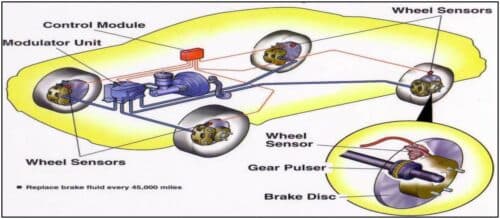
Source: – https://aermech.com/anti-lock-braking-system-abs-working/
2. Automatic Emergency Braking
An Automatic Emergency Braking is a safety system which detects an impeding forward crash with another vehicle and takes necessary actions to avoid or mitigate the crash. This system makes use of sensors fixed in the front of the car to continuously detect the distance from the car moving ahead. As soon as it senses the distance reducing beyond the set limit, it gives a warning to the driver to take corrective action to avoid the crash. If it finds the driver’s response insufficient of avoiding the crash, the AEB system automatically applies brakes to assist in preventing or mitigating the severity of the crash. Fig 5 shows the various stages of AEB system.

Source: – https://mycardoeswhat.org/safety-features/automatic-braking/
3. Hill Hold Control or Hill Start Assistance
Hill Hold Control or Hill Start Assistance is a safety system equipped in cars to avoid descending of the vehicle on the sloppy roads like those on a hill. This system uses a pitch sensor which detects the tilt of the body when the car is stopped on a sloppy road. After stoppage, when the driver releases the brake pedal, this sensor sends signal to the braking system to keep the wheels clamped for a few additional seconds which aids the driver to accelerate the vehicle thus preventing the descending of the car. Fig 6 shows a car on a sloppy road without and with the Hill Assist Control system.
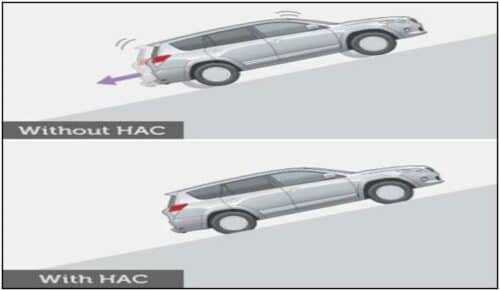
Source: – https://carbiketech.com/hill-start-assist/
4. Blind Spot Detection
Blind Spot Detection system is a safety system which provides 360 degrees of electronic coverage around the car. This system uses a set of sensors (or a combination of sensors and cameras) which are mounted on the side mirrors and in the rear bumper of the vehicle. These sensors detect vehicles in the adjacent lanes. If the sensors sense another vehicle getting closer to the car, they send an alert to the driver. It is generally an audible alert (beeping sound) to notify the driver of approaching vehicle which he might not be able to detect trough mirrors. Fig 7 highlights the working of the Blind Spot Detection system.
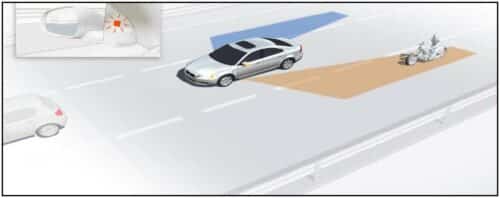
Source: – https://www.motortrend.com/news/blind-spot-monitoring/
5. Adaptive Cruise Control
Adaptive Cruise Control is a system that has been designed for cars to maintain a safe following distance and stay within the speed limit. The system automatically adjusts the speed of the car so that the drivers don’t need to do any efforts. This system uses a radar which is installed at the front of the car. When this system is activated, the radar continuously monitors the road. As long as the road is clear, this system maintains the speed of the vehicle set by the driver, however, if the radar detects a slower vehicle in front within the detection range, it sends signal to the Electronic Control Unit (ECU) to reduce speed of the car until the speed of the car is matched with the speed of the vehicle ahead. If the vehicle ahead increases its speed or changes its lane, then the Adaptive Cruise Control instructs the ECU to increase the speed back to the limit set by the driver. Fig 8 shows the various radars and the ranges that they cover.
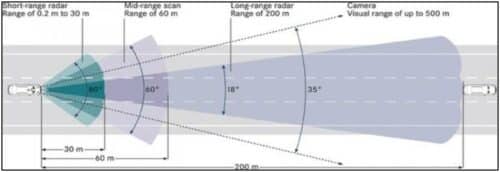
Source: – https://www.extremetech.com/extreme/157172-what-is-adaptive-cruise-control-and-how-does-it-work/2
6. Airbag Control System
Airbag Control System is a safety system installed in cars to safeguard the flailing occupants from injuries during the event of crash. This system consists of an airbag cushion, an inflation module, a flexible fabric bag and a set of impact sensors. These impact sensors are installed in the front and the sides of the car. When the car collides with something, its speed reduces drastically. The impact sensors detect this change and send signals to the Airbag Control Unit which in turn passes current through a heating element. This heating element ignites the chemical explosives which burn to generate massive amount of harmless gas which fills up in the nylon bag resulting in an inflation of the airbag. Fig 9 explains how an air bag is inflated under impact.
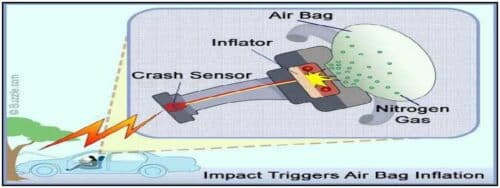
Source: – https://garatools.com/how-do-airbags-work/
7. Transparent Hood
Transparent Hood technology has been designed to aid the driver to have an accurate idea about the obstacles and the type of the terrain on which he/she is driving, which are not visible while driving. This system makes use of four satellite cameras and an Electronic Control Unit to reconstruct an image under the hood like an augmented reality display. Land Rover showcased this feature in the Discovery Vision concept in the year 2014. Fig 10 highlights the concept of a Transparent Bonnet.

Source: – https://evoindia.com/
8. Lane Departure Warning
Lane Departure Warning is a safety feature used in cars to discourage the drivers from leaving their lane. This system makes use of sensors that detect the markings on the roads. If the driver tries to merge into another lane without giving proper indications, these sensors detect the movement and issue continuous warnings to the driver to avoid merging. The advanced version of this technology self restricts this behaviour and adjusts the steering on its own with corrective braking system. Fig 11 shows a glimpse of the Steering Assist System.

Source: – https://evoindia.com/
9. Fatigue Detection
Fatigue Detection system is a safety system which monitors the fatigue of the driver who may feel drowsy or lack of concentration during a long trip. With the help of a set of sensors, this system senses the sudden deceleration or sudden braking or unnecessary lane departures and starts issuing alerts to take a break. Fig 12 shows driver alerts to prevent mishaps.
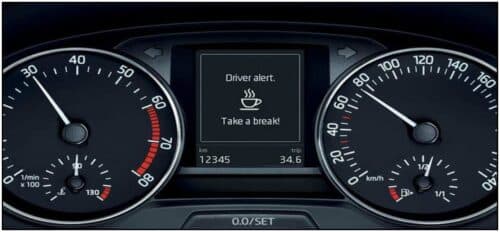
Source: – https://evoindia.com/
10. Electronic Stability Control
Electronic Stability Control system is a safety system which helps the driver maintain control over the car while going too fast around sharp corners. In cases of cars going at a high speed around sharp corners, there are chances of the car to skid off the road or collide with another car. In such scenarios, the Electronic Stability Control system applies brakes and modulates the throttle as required, to help the driver regain the lost control. Fig 13 shows the conditions of understeering and oversteering with and without the support of ESC.
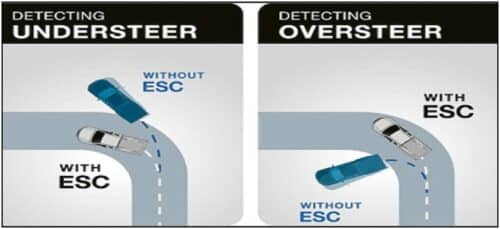
Source: – https://autobuzz.my/2018/01/24/electronic-stability-control-esc/
11. Night Vision Assist
Night Vision Assist is a system which makes the driver aware regarding the obstacles in the way while driving at night. This system makes use of thermal imaging cameras which are placed in the front of the car. These cameras spot animals or people on the road, by reading the heat signatures of anything within a range of 1,000 ft. These cameras generate an image on the dashboard screen, alerting the driver to be cautious and pay attention. Fig 14 demonstrates the working of a night vision assistance system enhancing visibility on road.
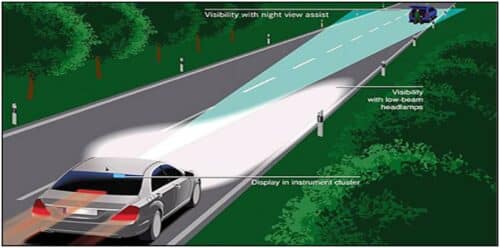
Source: – https://www.autocarindia.com/
12. Occupant Safety Monitoring
Occupant Safety Monitoring system is a safety system that monitors the position of the occupants in order to deploy air bags in case of a crash. This system makes use of infra-red light and image sensors to continuously detect the occupants in terms of their position in the seat and their movements. In case of a crash, the decision of which air bags to deploy is made based on the detected conditions of the occupants. Fig 15 shows the infrared and imaging sensor fixing up the locations of the occupants.
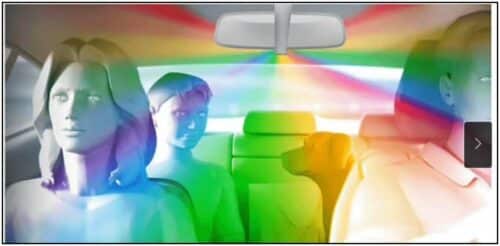
Source: – https://evoindia.com/





